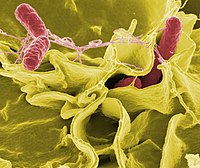
Photo from wikipedia
Abstract German cockroaches (Blattella germanica) can be both mechanical and biological (amplifying) vectors of enteric pathogens, including Salmonella enterica serovar Typhimurium (S. Typhimurium), which they acquire by feeding upon contaminated… Click to show full abstract
Abstract German cockroaches (Blattella germanica) can be both mechanical and biological (amplifying) vectors of enteric pathogens, including Salmonella enterica serovar Typhimurium (S. Typhimurium), which they acquire by feeding upon contaminated substances. Blattella germanica is also a gregarious species that shelters in groups and partakes in unique feeding behaviors such as conspecific coprophagy, necrophagy, and emetophagy. These properties create an interphase for potential horizontal transmission of pathogens among cockroach populations through the fecal‐oral route, which could in turn enhance transmission to humans and other animals. Here, we performed a series of experiments to determine: (1) whether horizontal transmission of S. Typhimurium infection takes place in B. germanica, (2) the prevalence of the phenomenon, and (3) the route(s) through which it may occur. We reveal that true horizontal transmission of S. Typhimurium occurs among B. germanica. That is, uninfected cockroaches acquire infection of the gut when co‐housed with orally infected conspecifics, albeit at low frequency. Furthermore, we provide definitive evidence that coprophagy and necrophagy are routes of transmission but could not exclude sharing of food or water as contributing routes. On the contrary, transmission by emetophagy appears less likely as oral regurgitates from infected cockroaches contained S. Typhimurium for less than one day after ingesting the bacteria. Together, our data enhance current understanding of the ecology of vector‐borne S. Typhimurium transmission by cockroaches, implicating conspecific horizontal transmission as a phenomenon that contributes to maintaining infected cockroach populations independently of contact with primary sources of the pathogen. Although the relative importance of horizontal transmission of pathogens in cockroaches in the field remains to be determined, these results also highlight the important role that food and water sources in the local environment may play in cockroach‐borne pathogen transmission and emphasize the importance of sanitation for not only abating infestations but also mitigating pathogen transmission.
Journal Title: Ecology and Evolution
Year Published: 2023
Link to full text (if available)
Share on Social Media: Sign Up to like & get
recommendations!